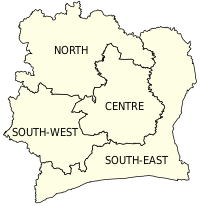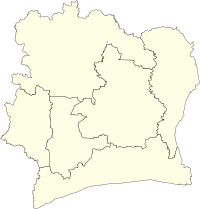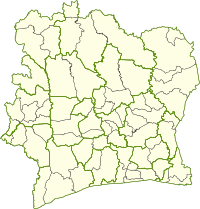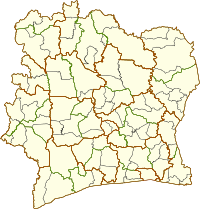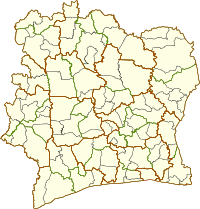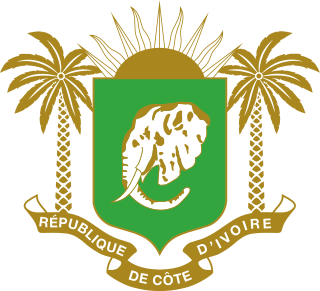
The regions of Ivory Coast are the second-level subdivisions of Ivory Coast. There are 31 regions, and each region is subdivided into two or more departments, the third-level division in Ivory Coast. Two to four regions are combined to make up an autonomous district, the first-level subdivision. The autonomous districts of Abidjan and Yamoussoukro are not divided into regions.

Sud-Bandama Region is a defunct region of Ivory Coast. From 1997 to 2011, it was a first-level subdivision region. The region's capital was Divo and its area was 10,677 km². Since 2011, the area formerly encompassed by the region is divided between Bas-Sassandra and Gôh-Djiboua Districts.

Gagnoa Department is a department of Gôh Region in Gôh-Djiboua District, Ivory Coast. In 2021, its population was 724,496 and its seat is the settlement of Gagnoa. The sub-prefectures of the department are Bayota, Dahiépa-Kéhi, Dignago, Dougroupalégnaoa, Doukouyo, Gagnoa, Galebre-Galébouo, Gnagbodougnoa, Guibéroua, Ouragahio, Sérihio, and Yopohué.

Zuénoula Department is a department of Marahoué Region in Sassandra-Marahoué District, Ivory Coast. In 2021, its population was 184,882 and its seat is the settlement of Zuénoula. The sub-prefectures of the department are Iriéfla, Kanzra, Vouéboufla, and Zanzra.

The communes of Ivory Coast are a fifth-level administrative unit of administration in Ivory Coast. The sub-prefectures of Ivory Coast contain villages, and in select instances more than one village is combined into a commune. There are currently 197 communes in the 510 sub-prefectures.

Abidjan Department is a department of Ivory Coast. It is the sole department in Abidjan Autonomous District: the territory of the department and the district are the same.

Adzopé Department is a department of La Mé Region in Lagunes District, Ivory Coast. In 2021, its population was 283,727 and its seat is the settlement of Adzopé. The sub-prefectures of the department are Adzopé, Agou, Annépé, Assikoi, Bécédi-Brignan, and Yakassé-Mé.

Bouaflé Department is a department of Marahoué Region in Sassandra-Marahoué District, Ivory Coast. In 2021, its population was 300,305 and its seat is the settlement of Bouaflé. The sub-prefectures of the department are Bégbessou, Bouaflé, N'Douffoukankro, Pakouabo, and Tibéita.

Daloa Department is a department of Haut-Sassandra Region in Sassandra-Marahoué District, Ivory Coast. In 2021, its population was 705,378 and its seat is the settlement of Daloa. The sub-prefectures of the department are Bédiala, Daloa, Gadouan, Gboguhé, Gonaté, and Zaïbo.

Sassandra Department is a department of Gbôklé Region in Bas-Sassandra District, Ivory Coast. In 2021, its population was 353,228 and its seat is the settlement of Sassandra. The sub-prefectures of the department are Dakpadou, Grihiri, Lobakuya, Médon, Sago, and Sassandra.

Odienné Department is a department of Kabadougou Region in Denguélé District, Ivory Coast. In 2021, its population was 156,730 and its seat is the settlement of Odienné. The sub-prefectures of the department are Bako, Bougousso, Dioulatièdougou, Odienné, and Tiémé.

Korhogo Department is a department of Poro Region in Savanes District, Ivory Coast. In 2021, its population was 748,393 and its seat is the settlement of Korhogo. The sub-prefectures of the department are Dassoungboho, Kanoroba, Karakoro, Kiémou, Kombolokoura, Komborodougou, Koni, Korhogo, Lataha, Nafoun, Napiéolédougou, N'Ganon, Niofoin, Sirasso, Sohouo, and Tioroniaradougou.

Dimbokro Department is a department of N'Zi Region in Lacs District, Ivory Coast. In 2021, its population was 102,192 and its seat is the settlement of Dimbokro. The sub-prefectures of the department are Abigui, Diangokro, Dimbokro, and Nofou.

Divo Department is a department of Lôh-Djiboua Region in Gôh-Djiboua District, Ivory Coast. In 2021, its population was 571,688 and its seat is the settlement of Divo. The sub-prefectures of the department are Chiépo, Didoko, Divo, Hiré, Nébo, Ogoudou, and Zégo.

Fresco Department is a department of Gbôklé Region in Bas-Sassandra District, Ivory Coast. In 2021, its population was 107,752 and its seat is the settlement of Fresco. The sub-prefectures of the department are Dahiri, Fresco and Gbagbam.

Soubré Department is a department of Nawa Region in Bas-Sassandra District, Ivory Coast. In 2021, its population was 587,441 and its seat is the settlement of Soubré. The sub-prefectures of the department are Grand-Zattry, Liliyo, Okrouyo, and Soubré.
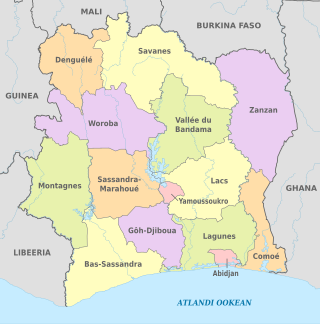
The districts of Ivory Coast are the first-level administrative subdivisions of the country. The districts were created in 2011 in an effort to further decentralise the state.

Sud Department was one of the original four departments of Ivory Coast. It was established in 1961, along with Centre Department, Nord Department, and Sud-Ouest Department. During Sud Department's existence, departments were the first-level administrative subdivisions of Ivory Coast.

Ouest Department was one of the original four departments of Ivory Coast. It was established in 1961, along with Centre Department, Nord Department, and Sud-Est Department. During Ouest Department's existence, departments were the first-level administrative subdivisions of Ivory Coast.

Centre-Ouest Department was a department of Ivory Coast between 1963 and 1969. It was established in 1963 as a split-off from Sud-Ouest Department. During Centre-Ouest Department's existence, departments were the first-level administrative subdivisions of Ivory Coast.






